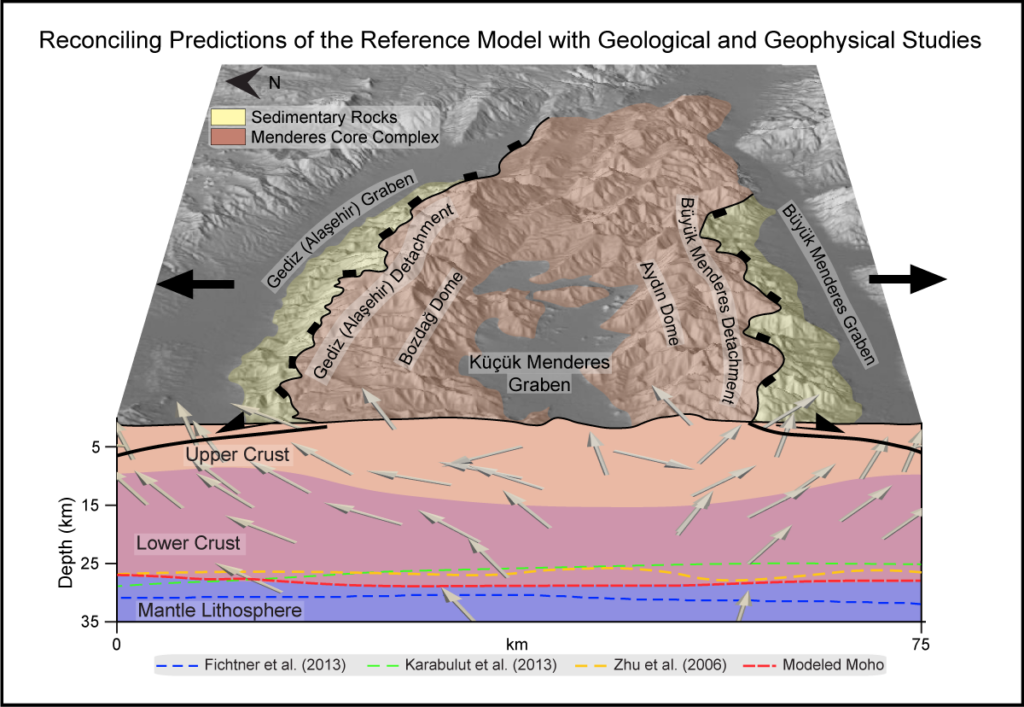When tension within tectonic plates pulls Earth’s crust apart, a certain type of fault forms. These features, termed normal faults, accommodate stretching in the crust and should be angled roughly 60° from horizontal, according to the long-standing theory of mechanics. But scientists have documented normal faults around the world that are much shallower than expected. Now, a group of researchers has found new evidence that a flowing lower crust could be forming these geological oddities.
According to Anderson’s theory of faulting, a widely accepted mechanical framework for how the crust breaks under stress, a fault should form 30° from the direction of greatest compression: In the case of stretching crust, that direction is roughly vertical. Normal faults should therefore form around 60° from horizontal.
But in many places, scientists find normal faults at shallower angles. The Menderes Massif in western Türkiye is one example. The Menderes is one of the most actively expanding regions on Earth, said Oğuz Göğüş, a geophysicist at Istanbul Technical University and one of the authors of the study. And normal faults throughout the region are angled at 20°.
For decades, geologists have suspected that a low-angle normal fault—also called a detachment fault—may form in one of two ways: It violates Anderson’s theory and breaks at a shallow angle, or it forms 60° from horizontal and is subsequently rotated. More recently, improved modeling techniques have allowed researchers to better understand how the crust behaves at large scales.
Previous fieldwork in western Anatolia during the 1990s hinted at rotation because sedimentary layers above the region’s faults had been tilted. Since then, questions have remained about the mechanism driving the rotation.
Steep to Shallow
“The implication is that the lower crust has to flow.”
The faults in the Menderes have accommodated so much stretching that they expose twin domes of metamorphic rocks from the middle to lower crust. This is one of the largest such exposures, known as metamorphic core complexes, in the world. The area has been extended by at least 100%. With that much stretching and thinning, heat rises, and the crust becomes weaker.
“The implication is that the lower crust has to flow,” said John Singleton, a structural geologist at Colorado State University who was not involved in this study. “It’s flowing from unextended areas or areas that have undergone less extension to areas that have undergone more extension,” he said. Though solid, the lower crust is pliable because of heat and pressure below around 15 kilometers. When the crust is thinned through extension, the overburden is removed, and the lower crust can flow upward. “You have this very hot buoyant lower crust,” Singleton said. “It’s actually going to rise, almost like a lava lamp.”
In the study, the researchers used geological data from western Anatolia to simulate the movement of rocks in a block of crust with a weak lower section. “Our models show that during extension, the deep, lower crust may flow horizontally and vertically, while the upper crust has faults, or high strain zones, formed and shaped in accordance with the flow beneath it,” Göğüş said.

Matching the Model to the Menderes
In the Menderes region, well-defined geology and seismic imaging of the crust suggest the faults initially formed at steep angles and then rotated—the study’s models explain how that could occur, Göğüş said.
Earlier data on the age and temperature history of rocks in the Menderes are consistent with the results of the model, according to the researchers. The model’s predictions also aligned with data from seismic tomography, which uses earthquake waves to image the structure of Earth’s interior, like a computerized tomography (CT) scan of a body.
“The really exciting thing about this numerical modeling is that you can compare it to the rocks that are outcropping.”
“Previous studies approach this problem from different angles,” Göğüş said. “Most of the time the modeling and the observations were not reconciled with each other.” The new study is the first to simulate a mechanism of rotating faults that is backed by geological, geophysical, and age data, Göğüş noted.
Numerical models are useful because they can correlate what scientists have observed and studied with processes that may still be unclear. “The really exciting thing about this numerical modeling is that you can compare it to the rocks that are outcropping,” said Robert Stern, a geologist at the University of Texas at Dallas who was not involved in the study. “That’s a check on reality that you may not have if you’re modeling, say, exoplanets.” he said. “This is a really useful example of how thoughtful, numerical experiments can explain geology.”
This research helps geologists comprehend not only how the Menderes Massif formed but how other metamorphic core complexes came to be. The study’s findings and modeling techniques can provide new insights into the geology of the western United States, the Himalayas, and the entire Mediterranean region, Göğüş said, and can help further the conversation about what links low-angle faults and metamorphic core complexes.
—Rebecca Owen (@beccapox), Science Writer

